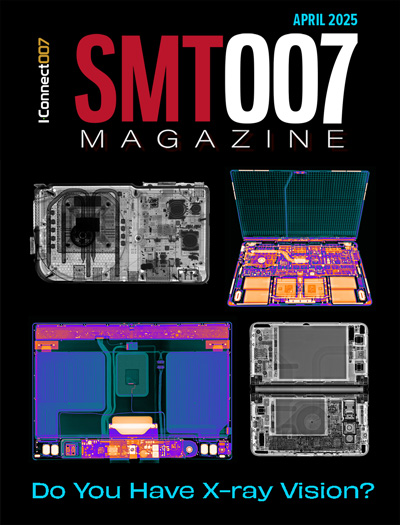-

- News
- Books
Featured Books
- smt007 Magazine
Latest Issues
Current Issue
Intelligent Test and Inspection
Are you ready to explore the cutting-edge advancements shaping the electronics manufacturing industry? The May 2025 issue of SMT007 Magazine is packed with insights, innovations, and expert perspectives that you won’t want to miss.

Do You Have X-ray Vision?
Has X-ray’s time finally come in electronics manufacturing? Join us in this issue of SMT007 Magazine, where we answer this question and others to bring more efficiency to your bottom line.

IPC APEX EXPO 2025: A Preview
It’s that time again. If you’re going to Anaheim for IPC APEX EXPO 2025, we’ll see you there. In the meantime, consider this issue of SMT007 Magazine to be your golden ticket to planning the show.
- Articles
- Columns
Search Console
- Links
- Media kit
||| MENU - smt007 Magazine
Estimated reading time: 2 minutes
The Shaughnessy Report: Rigid-flex Design No Longer a Niche
When I first started covering this industry in 1999, rigid-flex circuits were considered a niche market. In fact, Compaq was deemed a trendsetter for using rigid-flex in its laptops.
Now, analysts at Credence Research predict that the rigid-flex market will top $5 billion by 2026, led in part by the adoption of IoT and the need to connect a variety of smart devices. That’s a pretty big niche. Rigid-flex circuits are everywhere, from servers and smartphones to cameras and pacemakers.
Rigid-flex brings the best of both worlds together, with advantages that are not available with rigid or flex circuits alone. It cuts down on the number of connectors and wiring harnesses, and can fit into spaces where multiple rigid boards could never fit. Fewer connectors and solder joints means much higher reliability, as well as greater resistance to shock and vibration. Testing is simpler with rigid-flex than with a multi-board construction.
As a result, more traditional PCB designers are looking into rigid-flex design. But rigid-flex also brings challenges for designers of traditional rigid boards. Stackup design is a whole different animal with rigid-flex, especially with multiple rigid boards. Signal integrity analysis can be a real challenge here, and proper DFM practices are critical. Your data package is more important than ever. Are you conveying your design intent to your fabricator? Are you communicating with your fabricator during the design cycle?
This month in Design007 Magazine, we asked our expert contributors to share their best tips, tricks, and techniques for designing rigid-flex circuits. We start with a conversation with IPC instructor Kris Moyer, who explains the high points of his rigid-flex design class, while throwing in some DFA tips as well. Vern Solberg provides DFM techniques for flex and rigid-flex circuits. Bill Hargin details the finer points of designing stackups for rigid-flex. Mike Morando discusses what OEMs should consider when selecting a rigid-flex fabricator.
Tim Haag examines the often-overlooked correlation between human ingenuity and rigid-flex technology, and Cherie Litson offers a great set of rigid-flex design guidelines. Joe Fjelstad explains how to “unlock” some of the perhaps unseen benefits related to rigid-flex circuits. We also have a column by Matt Stevenson, and articles by Anaya Vardya (who begins a new series on the fundamentals of UHDI), Brad Griffin, and Léa Maurel of ICAPE, talking about sourcing diversification.
We’re coming up on trade show season, and I-Connect007 will be covering PCB West and SMTA International in the next few months. Hope to see you there.
This column originally appears in the September 2023 issue of Design007 Magazine.
More Columns from The Shaughnessy Report
The Shaughnessy Report: Always With the Negative WavesThe Shaughnessy Report: Breaking Down the Language Barrier
The Shaughnessy Report: Back to the Future
The Shaughnessy Report: The Designer of Tomorrow
The Shaughnessy Report: A Stack of Advanced Packaging Info
The Shaughnessy Report: A Handy Look at Rules of Thumb
The Shaughnessy Report: Are You Partial to Partial HDI?
The Shaughnessy Report: Silicon to Systems—The Walls Are Coming Down


